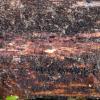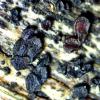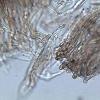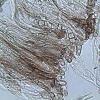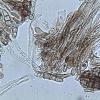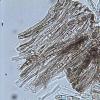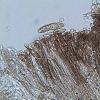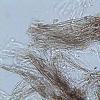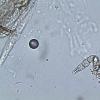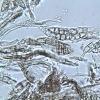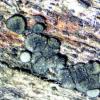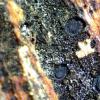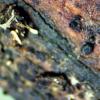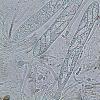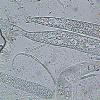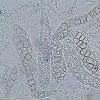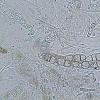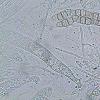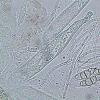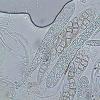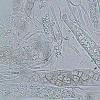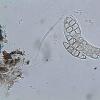
06-12-2025 00:19
 Viktorie Halasu
Viktorie Halasu
Hello, would anyone have this article, please? An

05-12-2025 17:33
 Bruno Coué
Bruno Coué
Bonjour, je serais heureux de recueillir votre avi

02-12-2025 18:59
This pair of ascos 2.5cm across were on recently b

02-12-2025 19:25
Buckwheat PeteHello, can anyone identify this hairy fungus growi

30-11-2025 12:53
 Edvin Johannesen
Edvin Johannesen
White short-stipitate apothecia found on thin twig

30-11-2025 10:47
 William Slosse
William Slosse
I recently found a collection of small Peziza sp.
Patellariopsis???
Blasco Rafael,
23-11-2015 11:50
 Hola, esta muestra esta sobre madera de Fagus. muy degradada. las muestras mas inmaduras tienen un himenio de color claro, para pasar a rojizo y despues a negro.
Hola, esta muestra esta sobre madera de Fagus. muy degradada. las muestras mas inmaduras tienen un himenio de color claro, para pasar a rojizo y despues a negro. Diametro 0,7--0,8, alguna llega a (1,1).
Ascas 102--118 x 11--12.
J+, crozier no visto.
Esporas 3 septos, 27--30 x 7--8.
Pelos cuubiertos de un gel marron.
Un saludo
Rfaael
Lothar Krieglsteiner,
23-11-2015 14:55

Hysteropatella ???
.. without looking up the spore-measurements: compare Hysteropatella cf. elliptica.
Regards from Lothar
Hans-Otto Baral,
23-11-2015 15:50

Re : Patellariopsis???
I think it could be a Patellariopsis, look the conical ascus apex with amyloid ring.
Are the spore light brown indeed? This would be untypical for the genus, however. Also the apothecial shape is too irregular. What could it be then?
Are the spore light brown indeed? This would be untypical for the genus, however. Also the apothecial shape is too irregular. What could it be then?
Blasco Rafael,
24-11-2015 12:39
Hans-Otto Baral,
24-11-2015 12:54

Re : Patellariopsis???
And they all belong to the same species, you are sure? This may well be and it could be that the brown spores are overmature. If you find living asci (don't press on the cover slip) then you can find out this. The usual Patellariopsis species have spore with more than 3 septa, escept for P. atrovinosa which has spores 4-6 µm wide. Your spores do not look so wide as you say. Would be good to find and measure more spores, preferably hyaline and alive.
Blasco Rafael,
25-11-2015 20:29

Re : Patellariopsis???
Foto del ejemplar empleado para micro, en este caso es con la zona himenial clara,
Hay muchas Ascas sin desarrollar, y otras con las esporas sin formar septos, pero tambien hay con los septos ya formados,
las esporas inmaduras tienen numerosas gotas en su interior, al desarrollar forman el septo central primero, para despues formarse los septos laterales.
Ascas entre 102--122 x 11--16, alguna es un poco mas grande que las medidas anteriores.
Esporas 25--30 x 6,5--8,2 similares a las medidas anteriores.
Todas con 3 septos.
pelos iguales a los anteriores.
Parafisis rectas y septadas multiples, hay otras que tienen el apice un poco capitado
Rafael
Hay muchas Ascas sin desarrollar, y otras con las esporas sin formar septos, pero tambien hay con los septos ya formados,
las esporas inmaduras tienen numerosas gotas en su interior, al desarrollar forman el septo central primero, para despues formarse los septos laterales.
Ascas entre 102--122 x 11--16, alguna es un poco mas grande que las medidas anteriores.
Esporas 25--30 x 6,5--8,2 similares a las medidas anteriores.
Todas con 3 septos.
pelos iguales a los anteriores.
Parafisis rectas y septadas multiples, hay otras que tienen el apice un poco capitado
Rafael
Hans-Otto Baral,
25-11-2015 20:50

Re : Patellariopsis???
So I think that the mature spores are hyaline, 3-septate, multiguttulate (lipid content about 3-4). P. atrovinosa has a high lipid content and much narrower spores, also the excipular color is different.
More I don't know.... I assume you found this around Benasque in the mountain? Lying exposed on the ground, not on the lower face?
More I don't know.... I assume you found this around Benasque in the mountain? Lying exposed on the ground, not on the lower face?
Blasco Rafael,
25-11-2015 21:11

Re : Patellariopsis???
Si es de Pirineo, la rama estaba contra el suelo, este detalle no es seguro.
P. atrovinosa ya la descarte por el color, no se correspondia.
Revisando el documento de la Dra. Vilma G. Rosato, no me saca de ninguna duda, ya que se base en especies de Argentina,
Con las que ella comenta no hay similitud.
la dejaremos como Patellariopsis pendiente de confirmacion.
Gracias por su interes
Rfaaael
P. atrovinosa ya la descarte por el color, no se correspondia.
Revisando el documento de la Dra. Vilma G. Rosato, no me saca de ninguna duda, ya que se base en especies de Argentina,
Con las que ella comenta no hay similitud.
la dejaremos como Patellariopsis pendiente de confirmacion.
Gracias por su interes
Rfaaael
